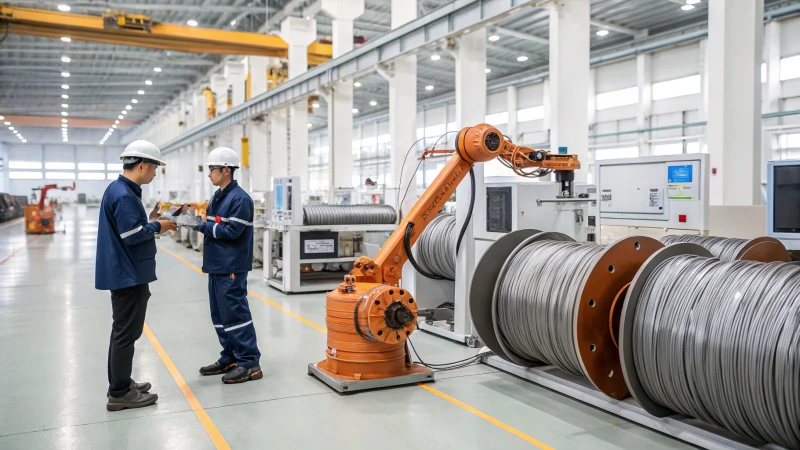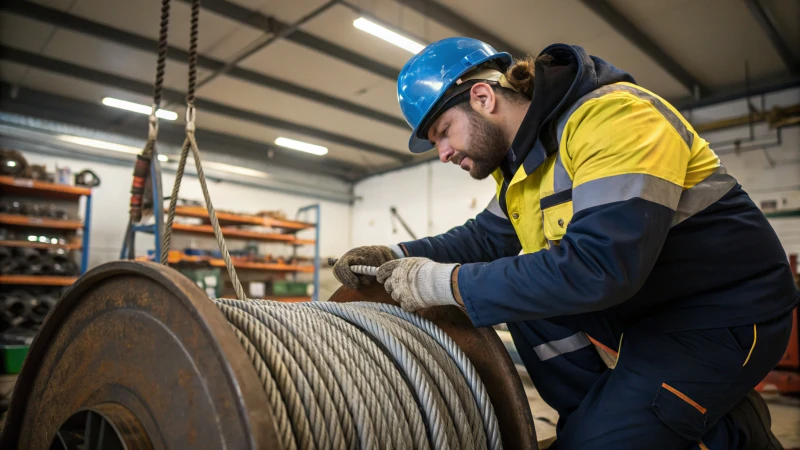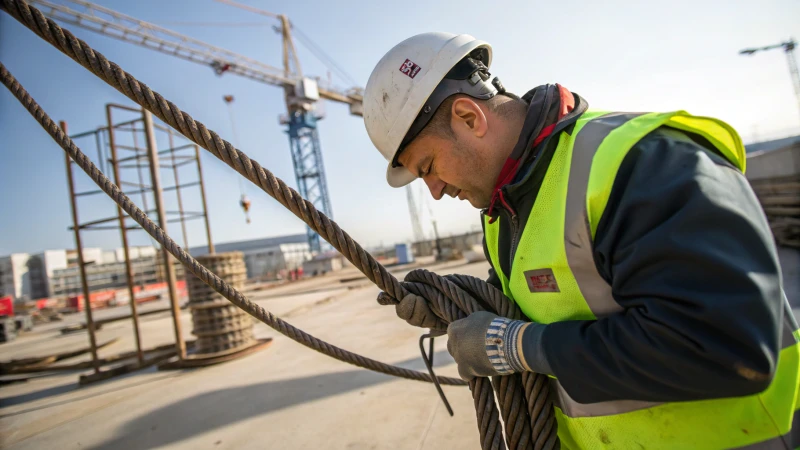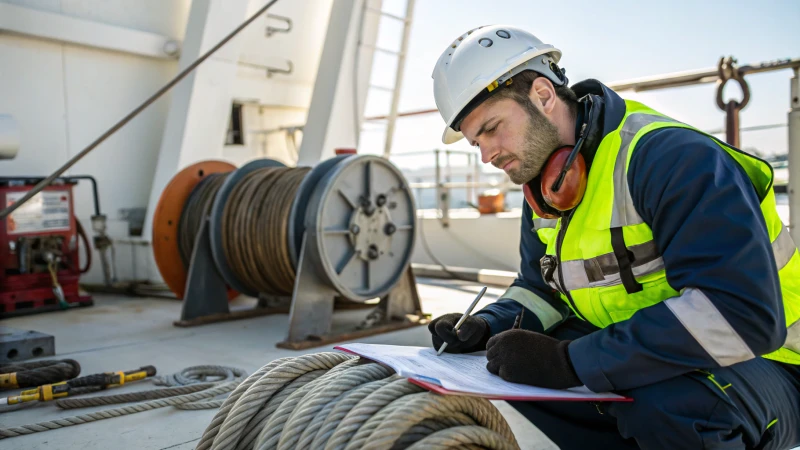
Let me take you on a journey through the world of steel wire ropes in automotive manufacturing.
To install and maintain steel wire ropes in automotive manufacturing, it's vital to adhere to industry-specific guidelines. Start by selecting the right rope type, ensure correct tension during installation, and regularly inspect for wear or damage. These steps help maximize safety and performance.
As someone who has spent countless hours in bustling manufacturing plants, I know firsthand the importance of maintaining equipment that works as hard as we do. Understanding the nuances of installing and maintaining steel wire ropes can make all the difference in ensuring smooth operations. From choosing the right type of rope to performing meticulous inspections, it's about more than just following a checklist—it's about safeguarding your work environment and boosting efficiency. Let's explore expert insights that can help you extend the lifespan of these essential components, saving time and resources in the long run.
Steel wire ropes are used for lifting in automotive plants.True
Steel wire ropes are essential for lifting tasks due to their strength.
Routine inspections of steel wire ropes are unnecessary.False
Regular checks are vital to detect wear or damage and ensure safety.
How Do I Install Steel Wire Ropes Correctly?
Steel wire ropes might seem like just another piece of equipment, but their installation is an art in itself. Let me walk you through it.
To install steel wire ropes effectively, select the right type, inspect for any damage, ensure proper drum winding, use suitable tools, and adhere to safety protocols. Proper tensioning and lubrication are also crucial for a successful installation.

Selecting the Right Steel Wire Rope
I remember my first project involving steel wire ropes—I was as nervous as a cat in a room full of rocking chairs. But choosing the right type of rope made all the difference. It’s like picking the right shoe for a marathon; load capacity, environment, and intended use must all be considered. Galvanized ropes1, for example, are my go-to for outdoor projects because they resist corrosion like champs.
Inspecting for Damage
Once, I skipped inspecting a rope before installation—big mistake. It turned out there were a few broken wires hidden beneath the surface. Regular inspections are like checking your car's oil; they can save you from a world of trouble down the road.
Ensuring Proper Drum Winding
Getting the winding right is critical. I learned this lesson after a rope snapped due to uneven spooling—a rookie error that taught me the importance of meticulousness. Refer to winding techniques2 to guide you through the process to ensure even spooling without overlaps.
Using Appropriate Tools
Using the right tools is non-negotiable. Trust me, using your bare hands is like trying to catch a greased pig! Gloves, wire rope clips, and tension meters are essentials in my toolbox to ensure both my safety and the rope's integrity.
Following Safety Guidelines
Safety guidelines aren’t just bureaucratic hoop-jumping; they’re lifesavers. I always ensure everyone on my team is trained and aware of potential hazards. It's akin to having a pre-flight checklist—necessary and reassuring. Use safety checklists3 for confirming that every step is completed correctly.
| Step | Action |
|---|---|
| Rope Selection | Choose based on application and environment |
| Damage Inspection | Check for visible wear and tear |
| Drum Winding | Ensure even spooling without overlaps |
| Tool Utilization | Use proper tools for handling and tensioning |
| Safety Compliance | Follow guidelines to protect workers and equipment |
Importance of Proper Tension and Lubrication
Proper tensioning can feel like balancing on a tightrope—it’s all about getting it just right. I’ve seen installations fail because of too much or too little tension. Lubrication is another silent hero; it reduces friction and keeps the rope running smoothly longer than you'd expect. Explore more about tensioning methods4 to nail this aspect of installation.
Galvanized ropes are best for indoor use.False
Galvanized ropes are ideal for outdoor use due to corrosion resistance.
Proper drum winding prevents premature rope wear.True
Even spooling without overlaps ensures the rope wears evenly.
How Can Regular Maintenance Extend the Life of Wire Ropes?
Ever wonder how something as simple as regular upkeep can breathe new life into your wire ropes?
Regular maintenance of wire ropes, including inspection, cleaning, lubrication, and timely replacement, is essential for longevity. This preventive care reduces wear and tear, minimizes failure risks, and can extend the lifespan by up to 25%.

The Importance of Inspection
Inspections became our lifeline. They allowed us to spot issues like corrosion or broken wires early on, much like how a routine health check-up catches potential problems before they escalate. Using techniques like magnetic particle inspection5 was a game changer for us, ensuring safety and reliability.
Cleaning and Lubrication Techniques
Cleaning felt like giving our ropes a fresh start. Removing dirt and contaminants wasn't just about appearance; it was about preventing premature wear. And lubrication? It became our secret weapon against friction and rust. Selecting the correct lubricants6 meant our ropes operated smoothly, regardless of their environment.
| Maintenance Task | Benefits |
|---|---|
| Inspection | Early detection of damage |
| Cleaning | Reduces abrasive wear |
| Lubrication | Minimizes friction and rust |
Understanding Wear Patterns
Different environments posed unique challenges. I remember working on a project near the coast where saltwater wreaked havoc on our equipment. Understanding wear patterns specific to marine settings7 helped us tailor our maintenance strategies effectively.
Timely Replacement of Damaged Parts
Replacing worn-out components became a proactive measure rather than a reactive one. It was like changing the oil in a car before the engine starts knocking—preventive maintenance that safeguarded both equipment and safety.
Role of Documentation and Training
We started keeping meticulous records of every maintenance activity. These logs were invaluable for planning future inspections and replacements. Training our team ensured everyone knew the ropes (pun intended), fostering a culture of safety and efficiency.
By prioritizing these maintenance strategies, I found that not only did we extend the lifespan of our wire ropes, but we also significantly improved operational safety. Regular maintenance isn't just a best practice; it's an essential investment in the longevity and reliability of our equipment.
Regular inspections detect wire rope damage early.True
Inspections identify wear signs, ensuring timely repairs.
Lubrication is unnecessary for wire rope longevity.False
Lubrication reduces friction and protects against corrosion.
What Common Mistakes Should Be Avoided During Installation?
Have you ever tackled an installation project only to realize later that a simple oversight cost you time and money?
Avoid common installation mistakes by ensuring proper alignment, following manufacturer guidelines, and using the correct tools. This attention to detail ensures optimal performance and longevity of your setup.

Understanding Manufacturer Guidelines
I've learned the hard way that skimming over the manufacturer's guidelines can lead to a host of problems. Once, while installing a new appliance, I ignored the instructions and ended up damaging a component. It's crucial to take the time to read and understand every step outlined in those guidelines.
Correct Alignment and Fitting
I remember a time when I thought I could eyeball an installation. The result? Misaligned parts that caused unnecessary wear and tear. Especially with steel wire ropes, alignment is critical. Always make sure to use the right tools for the job—something I learned after making do with a screwdriver instead of a proper alignment jig.
| Component | Correct Tools |
|---|---|
| Steel Wire Ropes | Torque Wrench, Alignment Jig |
| Bolts & Nuts | Spanner, Torque Wrench |
Using incorrect tools8 might compromise the integrity of the installation.
Regular Maintenance Checks
It’s tempting to assume everything is fine once installed, but skipping regular maintenance checks is a mistake I've seen lead to costly repairs. Establishing a routine check-up schedule can help catch wear and tear before it becomes a significant issue.
Avoiding Over-Tightening
There's nothing worse than hearing that dreaded crack from over-tightening bolts. Trust me, it happens! Always use a torque wrench to apply the right amount of force according to your manual. It's worth investing in good tools to avoid such mishaps.
Proper Environmental Considerations
I once underestimated the effect of environmental conditions on materials. For instance, using untreated steel wire ropes in marine environments9 led to quick corrosion. Always consider where you'll be installing something and what additional treatments might be necessary for durability.
By focusing on these areas, not only do you improve the longevity of your installations, but you also ensure safety and efficiency. It’s these little attentions to detail that make all the difference.
Ignoring manufacturer guidelines leads to improper fitting.True
Ignoring guidelines often results in installations that don't fit well.
Over-tightening bolts does not damage components.False
Excessive force can crack or damage installation parts.
How Do Industry Standards Influence Maintenance Practices?
Ever wondered how those industry standards actually shape our maintenance routines? Dive into how these guidelines ensure safety, efficiency, and compliance in our daily work lives.
Industry standards shape maintenance practices by setting guidelines for safety, operational efficiency, and compliance. These standards ensure consistency in maintenance tasks, reducing risks and enhancing equipment longevity.

Understanding Industry Standards
I've always found industry standards to be like an old friend who keeps you on the straight and narrow. They provide the benchmarks for quality, safety, and operational protocols that ensure everything runs smoothly. Imagine trying to keep a complex machine running without a guide—it's like trying to bake a cake without a recipe. That's why these standards are so crucial.
For instance, OSHA regulations10 set stringent safety measures for equipment handling.
Enhancing Safety Protocols
When I first started out, safety was always at the forefront of my mind. I remember my mentor drilling into us the importance of OSHA regulations—those stringent measures that keep everyone safe while working with heavy equipment. It was comforting to know that adhering to these protocols meant fewer accidents and more peace of mind. Regular safety audits and training sessions became a staple in fostering our culture of safety.
| Standard | Sector | Impact on Maintenance |
|---|---|---|
| OSHA | General Industry | Enforces safety compliance |
| ISO 55000 | Asset Management | Guides on efficient asset management |
Boosting Operational Efficiency
I've always been a fan of anything that makes work more efficient. Industry standards do just that by providing a framework for preventive maintenance. It reminds me of how regular check-ups for your car can prevent a breakdown, ensuring reliability and extending the life of your equipment.
Standards provide a framework for preventive maintenance, which can significantly enhance equipment reliability11.
Ensuring Compliance
Compliance can feel like a burden sometimes, but I've come to see it as essential for keeping operations smooth. It's not just about avoiding penalties—it's about maintaining integrity in what we do. We conduct regular audits and updates to procedures to keep up with these standards, ensuring we're always on the right track.
- Regular Audits: Ensure that all maintenance activities comply with current standards.
- Training Programs: Keep staff updated on the latest practices and technologies.
Conclusion
Industry standards are like the backbone of our maintenance practices. They offer a robust framework that we must actively implement and update to truly benefit from. It's an ongoing journey of learning and adapting, ensuring not just compliance but also enhanced operational efficiency and safety measures.
OSHA standards are optional for companies.False
OSHA standards are mandatory to ensure workplace safety and compliance.
ISO 55000 focuses on asset management efficiency.True
ISO 55000 provides guidelines for effective and efficient asset management.
Conclusion
Installing and maintaining steel wire ropes in automotive manufacturing requires careful selection, regular inspections, proper tensioning, and adherence to safety protocols to ensure longevity and operational efficiency.
-
Discover why galvanized ropes are preferred for outdoor applications due to their superior corrosion resistance. ↩
-
Learn detailed techniques for winding ropes on drums to prevent premature wear and enhance longevity. ↩
-
Access comprehensive checklists that ensure all safety protocols are followed during installation. ↩
-
Understand various methods to achieve optimal tensioning for efficient rope operation. ↩
-
Learn effective methods for identifying abrasion in wire ropes to prevent unexpected failures. ↩
-
Explore suitable lubricants that protect wire ropes from wear and corrosion. ↩
-
Understand methods to prevent corrosion in wire ropes exposed to saltwater environments. ↩
-
Discovering recommended tools ensures proper alignment, preventing stress and wear. ↩
-
Learn about protection measures against corrosion in marine settings for longevity. ↩
-
OSHA provides comprehensive guidelines on safety measures for equipment handling to prevent accidents. ↩
-
Understanding preventive maintenance can help in reducing downtime and increasing equipment lifespan. ↩

